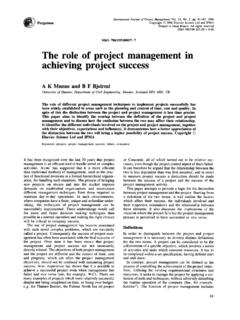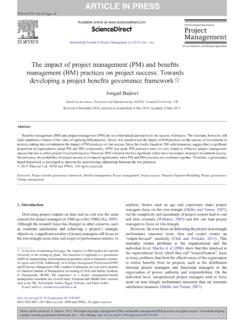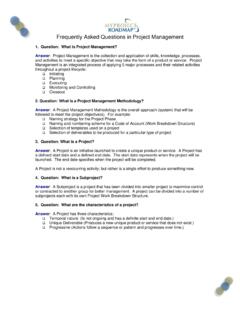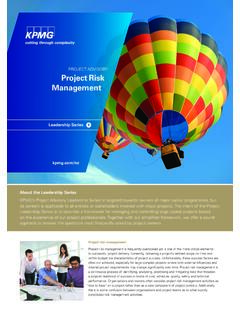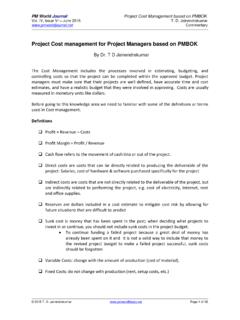Transcription of Project Management Office Operations Guide
1 Information Technology Services Project Management Office Operations Guide Revised 3/31/2015. Table of Contents ABOUT 4. WORKFLOW .. 5. Project LIFECYCLE .. 6. Project 6. Project PLANNING .. 7. Project EXECUTION, MONITORING AND CONTROLLING .. 8. Project CLOSEOUT .. 9. Project SCORING 10. SCORECARD CRITERIA WHY ARE WE DOING THIS AND HOW WILL IT BE COMPLETED? .. 10. GOALS .. 13. RISKS .. 13. SDLC SOFTWARE DEVELOPMENT LIFE CYCLE .. 14. WATERFALL MODEL .. 14. REQUIREMENTS .. 15. DESIGN .. 15. IMPLEMENTATION .. 15. VERIFICATION .. 16. MAINTENANCE .. 16. DEFINITION OF Project CLASSIFICATIONS .. 17. ACADEMIC TECHNOLOGIES .. 17. ADMINISTRATIVE SYSTEM 17. INFRASTRUCTURE IMPROVEMENTS .. 17. IT GOVERNANCE & STRATEGIC PLANNING .. 17. IT SECURITY .. 17. IT SERVICE IMPROVEMENTS & OUTREACH .. 17. RESEARCH TECHNOLOGY SERVICES.
2 17. STUDENT EXPERIENCE .. 17. DEFINITION OF Project 18. APPLICATION DEVELOPMENT / BANNER .. 18. Page | 2. BUSINESS INTELLIGENCE .. 18. CONSTRUCTION .. 18. PACE WEB SITE .. 18. SYSTEMS & INFRASTRUCTURE ADMINISTRATION .. 18. TRAINING / PROGRAM Management .. 18. DEFINITION OF TIERS .. 19. TIER 1 Minimal Complexity .. 19. TIER 2 Moderate 19. TIER 3 Highly Complex .. 19. QUALITY Management POLICY .. 20. LEVEL 1 .. 20. LEVEL 2 .. 20. RISK 21. ROLES AND 22. REQUESTOR .. 22. Project SPONSOR .. 22. Project MANAGER .. 22. FUNCTIONAL LEAD .. 22. STAKEHOLDER .. 22. 23. Project INITIATION CHECKLIST .. 23. PRODUCTION READY 24. COMMUNICATIONS PLAN .. 25. CHANGE Management .. 26. 27. PORTFOLIO Management TOOL .. 27. Team 27. Page | 3. ABOUT US. MISSION STATEMENT. The Project Management Office (PMO) leads and manages the portfolio of key IT and business process improvement projects.
3 The Office is responsible for selecting, managing and optimizing the Project resources and ensuring projects are aligned with the University's mission and strategic goals. PMO staff works in partnership with IT cross-functional departments to form cohesive teams to achieve Project objectives. PMO supports the successful Management of IT projects through application of leading Project Management practices. We also recognize that all projects are different and may require an adaptable approach to meet the client's needs. The PMO is also responsible for monthly posting of the Strategic and Tactical Plan reports. Our department homepage resides within Information Technology Services org site at > PMO homepage PURPOSE OF THIS DOCUMENT. This document describes in detail the process that the PMO intends to use during the initiating, planning, managing (controlling and executing), and closing stages of technology projects.
4 In defining this methodology, the PMO hopes to reach the following goals: Provide a common point of reference and a common vocabulary for talking and writing about the practice of Project Management for technology projects with ITS. Provide guidelines as to what is a Project Increase the awareness and professionalism of good Project Management Practice Define the roles of the Project Manager, Key Stakeholders, Technical and Business leads ORGANIZATION. Each section of this document is organized as follows: PROCESS OVERVIEW. GUIDELINES. Page | 4. WORKFLOW. The PMO receives and processes projects as follows: Request Initiated via ITS Internal IT Project Request Form Work D. Project is reviewed by PMO for approval NO. Re-evaluation needed to Meets Criteria for Project ? ensure alignment with University goals and/or priority justification YES.
5 R. Evaluator (PMO) Scores Project after consultation with client and assigns Functional Manager Application NO. Development ? YES. Document Scope of Work Determine Timeline Obtain approvals Follow Project Management Process D. outlined in PMO Operations Guide D. Page | 5. Project LIFECYCLE. Project INITIATION. PROCESS OVERVIEW. The Project Management Office is currently engaged in a variety of projects and initiatives and assists with ITS resource planning. The PMO critically analyzes all IT Project requests and recommends prioritization to the Chief Information Officer. The PMO defines a Project as follows: A group activity designed with a goal to produce a unique product, service or result It is considered temporary in that is has a definitive beginning and end time Has a defined scope and resources In alignment with the University's Strategic Goals Not associated with daily business Operations The effort requires at least 40 business hours of an individual staff member's time GUIDELINES.
6 A scope of work document (aka Statement of Work / SOW) will promote an early collaboration between the client and the Project team. Establishing a good rapport with your sponsors will ensure a cooperative spirit during Project lifecycle. The scope of work should be reviewed by all invested parties so that everyone involved can understand and agree on the proposed specs. The document includes: 1. Project Proposal 2. Benefits that can be expected 3. Technical approach (IT solution). 4. Approximate time table for delivery Formal acceptance of statement of work by the client is critical and required. PMO will also ensure the Project is in alignment with the University's strategic goals. Sample Statement of work template can be found on our website -> Sample SOW. Page | 6. Project PLANNING.
7 PROCESS OVERVIEW. Project planning defines the Project tasks and describes how the tasks will be accomplished. The PMO will focus on more clearly defining the Project scope and provide a framework for Management review and control. The PMO may schedule internal discussions with team leaders at this stage to gain an understanding of the effort involved and perform a preliminary sizing. A Project Initiation checklist 1 is used as a guideline. GUIDELINES. The PMO's planning process includes the following steps: 1. Estimating the size of the Project 2. Estimate the technical scope of the Project 3. Estimate the resources required to complete the Project 4. Produce a schedule 5. Develop a Communications Plan2. 6. Identify and assess risks 7. Negotiate commitments The PMO will assess whether or not the Project requires a formal Project plan or if a high-level list of milestones is more appropriate.
8 Several iterations of the planning process are performed before a formal plan is actually completed. 1. See CHECKLISTS section of the document 2. See COMMUNICATIONS section Page | 7. An appropriate Tier level will be decided upon after initial assessment. For more details on Tier levels, please see Definition of Tiers section3. If procurement is involved ( purchase of equipment or vendor resource), a budget is established and a formal RFP (Request for Proposal) or Quote will be prepared at this time. Management and Finance approvals are required before ordering equipment or contracting vendor resources. Project EXECUTION, MONITORING AND CONTROLLING. PROCESS OVERVIEW. Once a Project moves to this phase, the Project team is formed and the necessary resources are allocated to perform Project tasks outlined in the Project plan.
9 The Project Plan execution, monitoring & controlling process ensures the planned Project tasks are carried out in an effective and efficient way. The PMO is responsible for reporting Project progress and keeping Management informed of any issues that may arise. Any updates or changes in Project scope will be incorporated through a Change Management process. Change in scope can impact resource allocation and/or delivery timeline. GUIDELINES. The PMO will be responsible for the following: 1. Regular review of Project progress and creation of status reports 2. Schedule checkpoint meetings to update status 3. Control and track tasks in Project plan (deliverables on track). 4. Adhere to Quality Management and Risk Management Policies4. 5. Update Project plan (completion dates, new tasks, milestones).
10 6. Communicate risks and concerns to client and team 7. Change management5. 8. Obtaining appropriate sign offs for user acceptance testing and deliverables Periodic status reports are essential to communicate progress and team accomplishments. Status reports can also provide insight to next steps, as well as bring issues to the attention of the appropriate team for assessment. Clients are emailed a list of current ITS projects along with status on a scheduled basis. Checkpoint Team meetings are held with stake-holders as appropriate. 3. See DEFINITION OF TIERS section of the document 4. See QUALITY Management and RISK Management sections 5. See CHANGE Management section Page | 8. Project CLOSEOUT. PROCESS OVERVIEW. The final phase of the Project 's lifecycle is Project closeout. Project closeout is completed once all defined Project tasks and milestones have been completed and the customer has accepted the deliverables.






